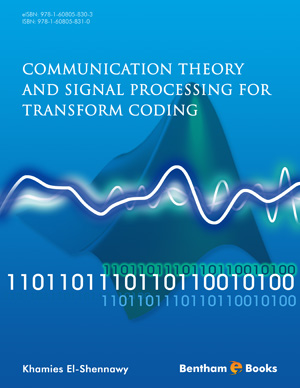About the Author
Page: i-i (1)
Author: Khamies M. A. El-Shennawy
DOI: 10.2174/9781608058303114010001
Communication System and Signals
Page: 3-16 (14)
Author: Khamies M. A. El-Shennawy
DOI: 10.2174/9781608058303114010004
PDF Price: $15
Abstract
Communication is the process where the information (message signal may be speech or text or picture), is transferred from point in space and time (source) to another point, through transmission channel (communication medium), separating the transmitter from the receiver. Communication enters our daily lives in many different ways, telephones, radios, televisions, and computer terminals. Communication also provides the senses for ships on the seas, aircraft in flights, and satellite in space.
Fourier Series and Power Spectra
Page: 17-32 (16)
Author: Khamies M. A. El-Shennawy
DOI: 10.2174/9781608058303114010005
PDF Price: $15
Abstract
Fourier analyses involve the resolution of signals into sinusoidal components to describe the spectral contents of the signals in the frequency domain. There are two major techniques of Fourier analyses namely: Fourier series and Fourier transform. Fourier series analysis resolves the periodic signal (power signal) into an infinite sum of sinusoidal wave components, while Fourier transform analysis performs a similar role in the analysis of the unperiodic signal (energy signal) which are more general use in the signal processing (chapter III). Fourier transform can also be used, in a limiting sense, to represent the periodic signals as an infinite sum of sinusoidal wave components (chapter V). An example, the frequency content of the direct current dc signal, is the zero frequency component only, while the frequency content of the signal x(t), Fig.2.1, are two components of frequencies: the zero frequency due to the dc component and the frequency f Hz due to the alternating current ac component imposed on the direct current. Then, as long as the amplitude of a signal varies, the signal contains certain frequency components.
Fourier Transform and Energy Spectra
Page: 33-80 (48)
Author: Khamies M. A. El-Shennawy
DOI: 10.2174/9781608058303114010006
PDF Price: $15
Abstract
In the time domain, the signal of constant amplitude does not contain frequency components while the signal of variable amplitude do contain frequency components. Fourier transform (Fourier integrals) is used for evaluating the frequency contents of the unperiodic signals and in a limiting sense for the periodic signals. Fourier transform provides a means of analyzing and designing frequency selective filters for the separation of signals on the basis of their frequency contents. This chapter is involved for performing the Fourier transform to obtain the continuous frequency spectrum of a given unperiodic signal x(t) such as energy signals and deterministic signals which has infinite periodic time To , finite energy, and zero average power. Fourier transform maps the signal x(t) from the time domain to its frequency domain X(f) in terms of the exponential functions. The waveform x(t) and its Fourier transform X(f) are separate aspects, dependent of each other and are related by Fourier transform analysis. Also in a limiting sense, Fourier transform represents the periodic signals such as power signals and random signals as an infinite sum of discrete sinusoidal wave components (chapter V).
Spectra of Nonintegrable Functions
Page: 81-102 (22)
Author: Khamies M. A. El-Shennawy
DOI: 10.2174/9781608058303114010007
PDF Price: $15
Abstract
The main evidence of the Fourier transform concludes that when the integral, Eq.(3.2), is absolutely integrable (finite), the Fourier transform exists. More sufficient evidence for the existence of the Fourier transform is, since the magnitude of the exponential e−j2πft, equals unity, then the integral
∞∫−∞|x(t)| dt < ∞ (3.3a), (Dirichlet`s conditions), Eq.(3.3a) must be finite (finite area), that is x(t) must be unperiodic signal (energy signal) which has finite energy, zero average power, and infinite periodic time To . But, is the condition of the absolutely integrable is always necessary, the answer is No, because there are some special functions are not absolutely integrable (do not satisfy Dirichlet`s conditions) and have Fourier transforms in the limit such as the Dirac delta function (unit impulse) δ(t), the unit step function u(t) and the signum function sgn(t), Fig.1.4. It is necessary to evaluate the Fourier transform of these non-integrable functions to obtain their continuous frequency spectrum and study how these functions allow the easy solution of many communication problems. Also some of these non-integrable functions are related to each other by mathematical differentiation and integration formulas.
Fourier Transform and Power Spectra
Page: 103-112 (10)
Author: Khamies M. A. El-Shennawy
DOI: 10.2174/9781608058303114010008
PDF Price: $15
Abstract
Fourier series analysis is performed to obtain the discrete spectrum representation of a given periodic signal (power signal) xp(t) which has finite periodic time To , finite average power and infinite energy, to describe its frequency components content (n/To), where n = 0, 1, 2, 3, 4, ... , by either using the real coefficients method to obtain the real coefficients an and bn, Equations (2.2) and (2.3), to construct xp(t), Eq.(2.1), or by using the complex coefficient method to obtain the complex coefficient Cn , Eq.(2.13) to construct the real value of xp(t), Eq.(2.12), (chapter II). While Fourier transform analysis is performed to obtain the continuous spectrum representation of a given unperiodic signal (energy signal) x(t) which has infinite periodic time To , finite energy, and zero average power (chapter III). Fourier transform is also used in a limiting sense, to evaluate the frequency content of the periodic signal xp(t). Moreover, there are some special periodic functions cannot be solved using Fourier series analysis such as the periodic Dirac delta function, in this case, Fourier transform is the only way to evaluate its frequency content.
Correlation Function and Spectral Density
Page: 113-140 (28)
Author: Khamies M. A. El-Shennawy
DOI: 10.2174/9781608058303114010009
PDF Price: $15
Abstract
Real random processes (stochastic processes) exhibit unpredictable changes with time and defy precise prediction. Practically, it is not possible to determine the probability distribution function of these real random processes. Then it is important to describe partially the mean, the correlation function and the covariance function of these real random processes which is defined by stationary processes or Ergodic processes. The collection of all possible recording of these processes, is called an ensemble. The ensemble correlation functions play an important role in the design of the correlation receiver and the matched filter receiver. The correlation function studies the statistically dependent and independent relation between two real random processes. The correlation function is independent of the time and depends only on the time difference (delay).
Signal Transmission and Systems
Page: 141-166 (26)
Author: Khamies M. A. El-Shennawy
DOI: 10.2174/9781608058303114010010
PDF Price: $15
Abstract
Linear system is a physical device that produce an output signal y(t) in response to an input signal x(t), such as filters or communication channels operating in their linear region. The filter is a frequency selective device that is used to limit the spectrum of a signal to some band of frequencies while the communication channel is a transmission medium that connects the transmitter to the receiver through a certain band of frequencies. The linear system refers to superposition principle, where the response of a linear system to a number of different inputs applied simultaneously, equals the sum of the responses of the system when each input is applied individually. While, time invariant system refers to the principle of, if the input signal is delayed by certain delay, the output signal will be delayed by the same amount of delay.
Hilbert Transform
Page: 167-176 (10)
Author: Khamies M. A. El-Shennawy
DOI: 10.2174/9781608058303114010011
PDF Price: $15
Abstract
The Fourier transform is used for evaluating the frequency content of the energy signal (chapter III) and in a limiting sense the power signal (chapter V). The Fourier transform analysis provides a means of analyzing and designing the frequency selective filters for the separation of signals on the basis of their frequency content, where the frequency selectivity plays the main role in the design of the communication systems. The Hilbert transform plays the same role depending on the phase selectivity. The Hilbert transform uses the phase shifts between the signals to achieve the desired separation, where the phase angles of all components of a given signal are shifted by ±90°, the resulting function of time is known as the Hilbert transform of the signal.
Narrow Band-Pass Signals and Systems
Page: 177-192 (16)
Author: Khamies M. A. El-Shennawy
DOI: 10.2174/9781608058303114010012
PDF Price: $15
Abstract
In the communication systems, many information bearing signals are transmitted by service type of carrier modulation. The channel over which the signal is transmitted is limited in bandwidth to an interval of frequencies centered at the carrier as in the double side-band modulation techniques, Fig.1.13b, or adjacent to the carrier as in the single side-band modulation techniques, Fig.9.1a,b.
Numerical Computation of Transform Coding (Compression Techniques)
Page: 193-250 (58)
Author: Khamies M. A. El-Shennawy
DOI: 10.2174/9781608058303114010013
PDF Price: $15
Abstract
Numerical computation of Fourier transform is particularly well suited for use on a Digital computer, and is defined by Discrete Fourier Transform DFT and Fast Fourier Transform FFT. Also, more efficient transforms such as Discrete Cosine Transform DCT, Discrete Wavelet Transform DWT, and Contourlet Transform CT are developed.
Abbreviations
Page: 284-288 (5)
Author: Khamies M. A. El-Shennawy
DOI: 10.2174/9781608058303114010016
Introduction
This book is tailored to fulfil the requirements in the area of the signal processing in communication systems. The book contains numerous examples, solved problems and exercises to explain the methodology of Fourier Series, Fourier Analysis, Fourier Transform and properties, Fast Fourier Transform FFT, Discrete Fourier Transform DFT and properties, Discrete Cosine Transform DCT, Discrete Wavelet Transform DWT and Contourlet Transform CT. The book is characterized by three directions, the communication theory and signal processing point of view, the mathematical point of view and utility computer programs. The contents of this book include chapters in communication system and signals, Fourier Series and Power Spectra, Fourier Transform and Energy Spectra, Fourier Transform and Power Spectra, Correlation Function and Spectral Density, Signal Transmission and Systems, Hilbert Transform, Narrow Band-Pass Signals and Systems and Numerical Computation of Transform Coding. This book is intended for undergraduate students in institutes, colleges, universities and academies who want to specialize in the field of communication systems and signal processing. The book will also be very useful to engineers of graduate and post graduate studies as well as researchers in research centers since it contains a great number of mathematical operations that are considered important in research results.




















